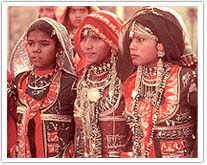Tribal Music & Dances
 Music
and dances are such an essential part of tribal life that professional
musicians and dancers are redundant. The Garasia tribal inhabit the Abu
Road and pindwara tehsils of Sirohi districts and the neighbouring
terrotories of Kotra, gogunda and khewara tehsils of Udaipur districts,
Bali and desuri of pali districts.
Music
and dances are such an essential part of tribal life that professional
musicians and dancers are redundant. The Garasia tribal inhabit the Abu
Road and pindwara tehsils of Sirohi districts and the neighbouring
terrotories of Kotra, gogunda and khewara tehsils of Udaipur districts,
Bali and desuri of pali districts.
They have a folklore enriched
with folktales, proverbs, riddles and folkmusic. Walar is an important
dance of the Garasias which is a prototype of the Ghoomar dance. Their
dances are generally accompanied by the beats of the mandal, change and a
variety of other musical instruments which provide a lively rhythm to
their dance sequences.
The most famous Bhil dance is the Gawari,
a dance go from village to village for a month, during which the nine
functionaries follow a stricts regimen. The main character are Rai Buriya,
the shiva, his two rais and Katkuria, the comic handman. Between the
enactment of various episodes, the entire troupe dances around a central
spot consecrated to a deity.
The dance is accompanied by a Madal
and a thali. The Ghoomar is the characteristic dance of the Bhils. Men and
women sing alternately and move clockwise & anticlockwise giving free
and intended play to the ample folds of the ghagra. The music of the
primitive group of Sahariyas (Sourias) of Shasbad, Kota, shows central
Indian links, with their songs speaking of Ram & Sita. The fairs of
the Meenas had a lot of free dancing which is unfortunately on the wane.
Vibrant, vigorous, graceful, sinuous, plantive and marital the
dance and music Rajasthan evoke the desert in all its moods. It is most
lilting tribute to the spectacular beauty, the undulating sinuousness and
the brutal harshness of the landscape, and to the hardiness and heroism of
the people who live in this land of the Kings.
About
Rajasthan| Cities to Visit |
Travel Circuits |
Places of Interest
Fairs
& Festivals | Folk Music &
Dances | Gems & Jewellery |
Museums of Rajasthan
Adventure Tourism |
Pilgrim Centres |
Nature Cure & Yoga Centres |
Shopper's Paradise
 Music
and dances are such an essential part of tribal life that professional
musicians and dancers are redundant. The Garasia tribal inhabit the Abu
Road and pindwara tehsils of Sirohi districts and the neighbouring
terrotories of Kotra, gogunda and khewara tehsils of Udaipur districts,
Bali and desuri of pali districts.
Music
and dances are such an essential part of tribal life that professional
musicians and dancers are redundant. The Garasia tribal inhabit the Abu
Road and pindwara tehsils of Sirohi districts and the neighbouring
terrotories of Kotra, gogunda and khewara tehsils of Udaipur districts,
Bali and desuri of pali districts.